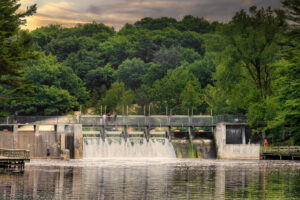
Hamlin Lake Dam
Read about the mighty dam that lives in Hamlin Lake, how it came to be and how it is utilized to help protect this man-made lake.
Vintage photo by John Penrod
Little is known about the lost village of Hamlin, which was in existence for just over 50 years and was located where the Ludington State Park now stands.
In 1852, Charles Mears purchased land along the Big Sable River, in search of a mill location. The mouth of “Big Sable Lake,” with its narrow stream to Lake Michigan seemed the ideal location. Mears built the first wooden dam and established a sawmill in 1856. This dam was located a few hundred feet downstream from the present-day dam, and raised the lake 12-15 feet. A smaller, wooden dam in the lower Sable held back water to create a large holding pond for logs- thus the creation of Hamlin Lake.
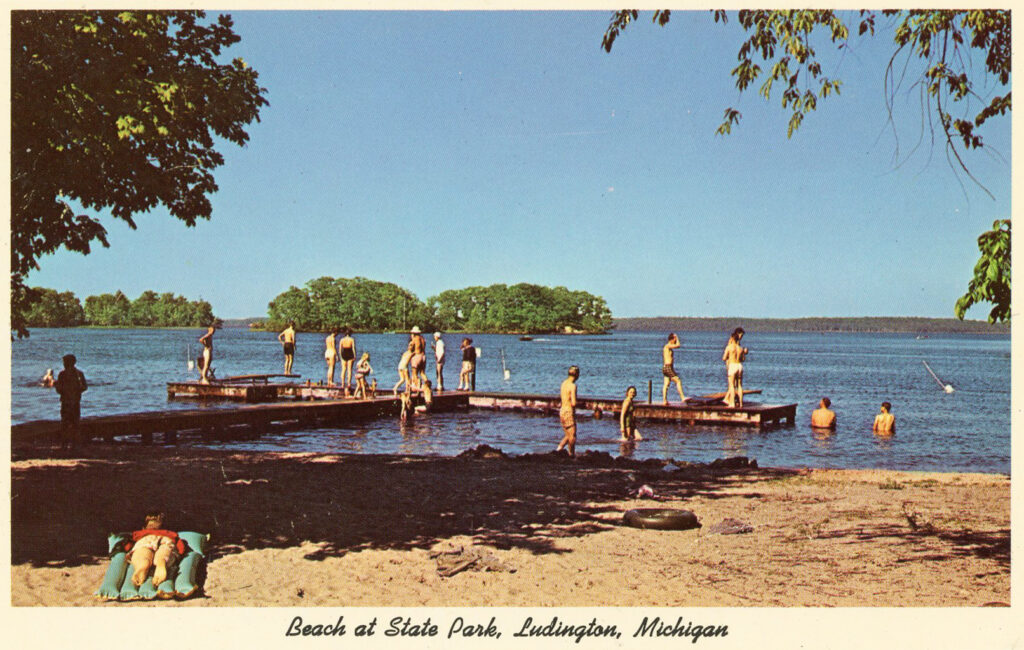
In 1860, Mears renamed his Little Sable settlement Lincoln and the Big Sable settlement and lake Hamlin, in honor of Mears’ choice for president and vice president, Abraham Lincoln and Hannibal Hamlin.
Mears owned rights to more than 200 million feet of standing timber in Mason and Lake counties. Logs were cut in winter, stacked on the ice, and moved down into Hamlin Lake each spring. The Mud Hen was built in 1865 to move the logs about Hamlin Lake, and was the first steam-powered boat in the region, operating for over 50 years.
Near the dam, the water-powered shingle mill cut about 15 million shingles a year and employed 60 men. Mules pulled carts loaded with shingles along a narrow-gauge railway from the mill, along the river to the docks. Other logs floated downriver to the holding pond. The logs were then cut at the steam-powered mills near the Lake Michigan docks.
Hamlin was a bustling village in the 1870s, consisting of mills, boarding houses, sheds, stores, and a schoolhouse. Then in 1888, the wooden dam collapsed. A huge wall of water moved houses, buildings, and debris into Lake Michigan. A second dam was built, but in 1912, that one too, broke and washed away all remnants of the village of Hamlin. A few dwellings remained until the 1930s, but they were removed by the Civilian Conservation Corps in preparation for construction of the new state park.
Since the demise of the lumber industry, there was no need to build a functional dam. But along the Hamlin Lake shoreline (the former holding pond), businesses, homes, and resorts had begun to spring up, establishing what is now known as a beautiful vacation getaway, the Hamlin Lake area.
A new, concrete dam was completed in 1914, about 100 yards upstream from the original dam, within the Ludington State Park. And underneath Hamlin Lake lies a bit of Mason County history- a 50-year-old village that played an important part in the development of this region.
A piece of Hamlin history can be toured at Ludington’s Historic White Pine Village, as well. The relocation of a log cabin known as “Hamlin Lake Cottage” from Indian Pete Bayou to White Pine Village was completed in 2015. Thousands of man hours went into disassembling the cabin and reassembling it on a concrete slab within the village.
Dwight “Scotty” Scott bought the Wrens Roost Restaurant on Hamlin Lake in 1964.The Wrens Roost became a favorite restaurant for locals and Hamlin Lake tourists, made all the more popular by its waterfront views and parking for boats.
Unfortunately, the Wrens Roost burned to the ground in 1977 and rebuilding the restaurant at the same location wasn’t an option. Not to be deterred, Scott purchased the Swedish Coffee Pot on Ludington Avenue in 1977, renamed it “Scotty’s” and it quickly became known as an exceptional steak and seafood restaurant. Scotty’s restaurant is still serving today, under new ownership.
Hamlin Lake is a beautiful 5,000 acre water paradise just north of Ludington in West Michigan! Read the stories below or go to the Hamlin Lake destination page.
Long Skinny Park is located on Lower Hamlin Lake between the South and Middle bayous. Perfect for fishing or taking in the view.
Small destinations within themselves, visitors of Hamlin Lake will go on an adventure to find their perfect dune.
This Hamlin Lake Fishing Map details what kind of fish you might catch in various sections of the lake. Helpful for all anglers.
Convenient and online, this Hamlin Lake Business Directory features businesses of interest in the Hamlin Lake area.
Enjoy this small, relaxing park as an easy place to place your boat in the water or throw a line out to catch some pan fish for dinner.
With some of the best fishing and boating around, Hamlin Lake brings much delight as well as some of the most beautiful, scenic backdrops.
Cast your line into Upper Hamlin Lake or enjoy a picnic, the playground, or watch Hamlin Lake's Independence Fireworks at Wilson Hill Park.
Read about the mighty dam that lives in Hamlin Lake, how it came to be and how it is utilized to help protect this man-made lake.
Read about the history of Hamlin Lake, when it was created, and the major role this lake played in the milling industry in Ludington.
Enjoy a picnic by Upper Hamlin Lake. With grills, a pavilion and picnic tables available, this park provides the perfect family setting.
The Michigan DNR has announced that Ludington State Park will be closed from September 3rd, 2024-July 1st, 2025 for improvements.
Hamlin Lake is where you want to be. It offers terrific summer recreation, including swimming, boating, tubing, and more!
Take a paddle down the Hamlin Lake Canoe Trail. Venture out on the trip yourself, or join a guided trip lead by Dune Grass Concessions.
Explore Hamlin Lake by boat, and you'll see why Hamlin Lake is one of the most beautiful lakes in Michigan. Over 5,000 acres, pure enjoyment!
If there's one thing that Hamlin Lake is known for, it's excellent fishing. Catch crappie, bluegill, and more across thousands of acres.
Hamlin Lake is home to several parks and numerous dunes for exploration and leisure. Pack a picnic, cast your line, and enjoy the sites.
The Hamlin Lake Beach within the Ludington State Park is fun for the whole family! With a dedicated, weed-free swimming area and more!
Just minutes away in Ludington proper, you will find more area history to enjoy. Check out these favorite attractions to immerse yourself in history:
The Mason County Lumber Heritage Trail
The Mason County Sculpture Trail
The Mason County Barn Quilt Trail

Read about the mighty dam that lives in Hamlin Lake, how it came to be and how it is utilized to help protect this man-made lake.
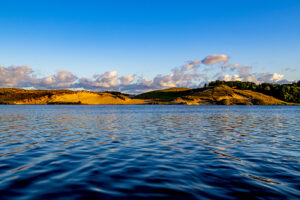
Small destinations within themselves, visitors of Hamlin Lake will go on an adventure to find their perfect dune.
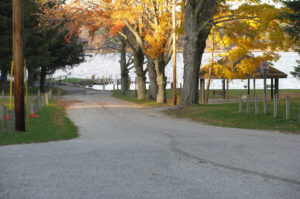
Cast your line into Upper Hamlin Lake or enjoy a picnic, the playground, or watch Hamlin Lake’s Independence Fireworks at Wilson Hill Park.
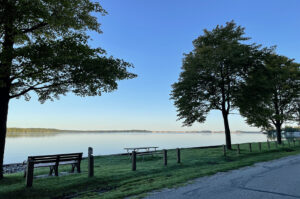
Long Skinny Park is located on Lower Hamlin Lake between the South and Middle bayous. Perfect for fishing or taking in the view.
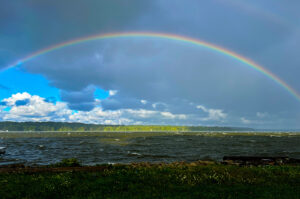
With some of the best fishing and boating around, Hamlin Lake brings much delight as well as some of the most beautiful, scenic backdrops.
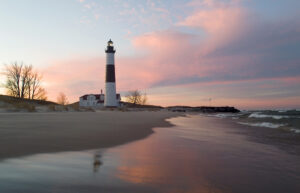
There are so many things to see and do in Ludington! Don’t miss a single activity during your visit by exploring VisitLudington.com!
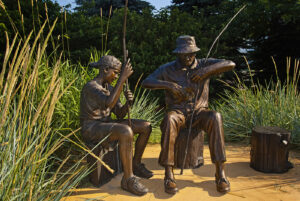
The bronzed sculptures in Ludington’s 5-acre Waterfront Park sets it apart from other parks. The park is situated on the Lake Michigan inlet.
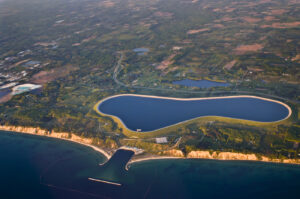
The Ludington Pumped Storage Plant and Lakewinds Energy Park are generating electricity for Ludington and West Michigan!
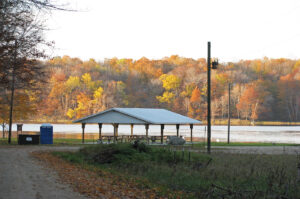
Enjoy a picnic by Upper Hamlin Lake. With grills, a pavilion and picnic tables available, this park provides the perfect family setting.
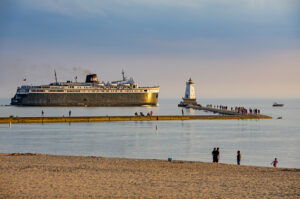
Where’s the best place to watch the S.S. Badger arrive or depart Ludington? Here are great locations for viewing the Lake Michigan Carferry.
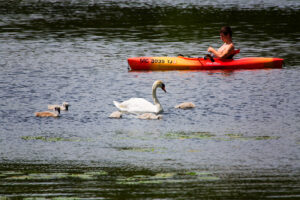
Take a paddle down the Hamlin Lake Canoe Trail. Venture out on the trip yourself, or join a guided trip lead by Dune Grass Concessions.
| Cookie | Duration | Description |
|---|---|---|
| cookielawinfo-checkbox-advertisement | 1 year | Set by the GDPR Cookie Consent plugin, this cookie records the user consent for the cookies in the "Advertisement" category. |
| cookielawinfo-checkbox-analytics | 1 year | Set by the GDPR Cookie Consent plugin, this cookie records the user consent for the cookies in the "Analytics" category. |
| cookielawinfo-checkbox-functional | 1 year | The GDPR Cookie Consent plugin sets the cookie to record the user consent for the cookies in the category "Functional". |
| cookielawinfo-checkbox-necessary | 1 year | Set by the GDPR Cookie Consent plugin, this cookie records the user consent for the cookies in the "Necessary" category. |
| cookielawinfo-checkbox-others | 1 year | Set by the GDPR Cookie Consent plugin, this cookie stores user consent for cookies in the category "Others". |
| cookielawinfo-checkbox-performance | 1 year | Set by the GDPR Cookie Consent plugin, this cookie stores the user consent for cookies in the category "Performance". |
| CookieLawInfoConsent | 1 year | CookieYes sets this cookie to record the default button state of the corresponding category and the status of CCPA. It works only in coordination with the primary cookie. |
| elementor | never | The website's WordPress theme uses this cookie. It allows the website owner to implement or change the website's content in real-time. |
| rc::a | never | This cookie is set by the Google recaptcha service to identify bots to protect the website against malicious spam attacks. |
| rc::c | session | This cookie is set by the Google recaptcha service to identify bots to protect the website against malicious spam attacks. |
| viewed_cookie_policy | 1 year | The GDPR Cookie Consent plugin sets the cookie to store whether or not the user has consented to use cookies. It does not store any personal data. |
| Cookie | Duration | Description |
|---|---|---|
| _ga | 1 year 1 month 4 days | Google Analytics sets this cookie to calculate visitor, session and campaign data and track site usage for the site's analytics report. The cookie stores information anonymously and assigns a randomly generated number to recognise unique visitors. |
| _ga_* | 1 year 1 month 4 days | Google Analytics sets this cookie to store and count page views. |
| _gat_UA-* | 1 minute | Google Analytics sets this cookie for user behaviour tracking.n |
| _gid | 1 day | Google Analytics sets this cookie to store information on how visitors use a website while also creating an analytics report of the website's performance. Some of the collected data includes the number of visitors, their source, and the pages they visit anonymously. |